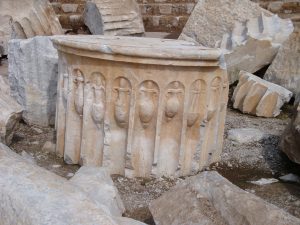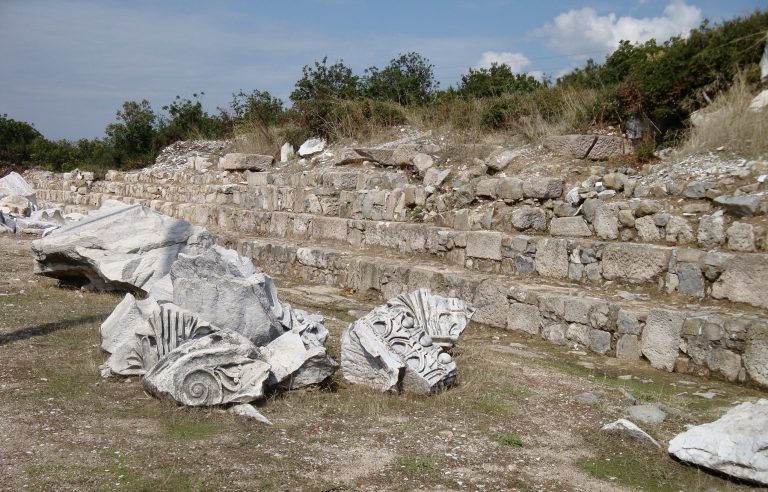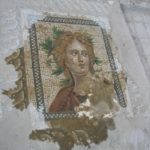A lost metropolis
If you’re staying in Erdek you might want to visit the ruins of ancient Cyzikus, just off the road towards Bandırma at the start of the Kapıdağ (Door Mountain) Peninsula.
This is a truly melancholy site, a place to come to ponder the curious twists taken by the wheel of fortune. Almost nothing now survives of what was once a huge town bar the stepped base of a temple and a vast quantity of glistening white marble. However, if you inspect those marble fragments more closely you will begin to realise that there must once have been more to this place than meets the modern eye. For this was once a town so impressive that its amphitheatre would be flooded from time to time so that mock sea battles could be staged in front of audiences.
Backstory
Sure enough, the history books have a lot to say about Cyzikus, comparing it in importance to such illustrious sites as Ephesus and Byzantium.
Originally what is now the Kapıdağ Peninsula was an island known as Arctonessus (Bear Island). At the strategic point where it could be linked to the mainland with bridges, Cyzikus was apparently founded by colonists from Miletus in 756 BC who returned to refound it in 675 BC.
According to Greek mythology Jason and the Argonauts arrived here during their search for the famous Golden Fleece. Later, the Cyzikans made a name for themselves by developing an early form of coinage which they marketed to the Athenians.
Sitting on the steps of the abandoned temple, it’s even harder to imagine that this part of Turkey once formed part of the Persian Empire than it is to believe that Erdek was a favourite of the 1960s’ jet set, but Cyzikus wisely refused to join the other Greek city states in rising up against their Persian overlords, thereby saving itself from the destruction meted out on the rebels in 494 BC.
Records show that Cyzikus was the biggest local tributary of Persia, a clear indication of its size and importance, which was later cemented by an alliance with the rising power of the Pergamene kings based in what is now Bergama. King Attalus I of Pergamum even married a Cyzikan woman called Apollonis in whose name her sons later built the first known temple on this site.
In Roman times Cyzikus was still an important city visited by the Emperor Hadrian in 124. At once he ordered the construction of a temple to himself which was completed during the reign of his successor Aurelius in 167. This temple, whose wretched base is almost all that remains today, was at the time the largest in Asia Minor, and went on to supplant the Temple of Artemis at Ephesus on some people’s lists of the Seven Wonders of the Ancient World.
But no matter how big and powerful it was, even Cyzikus was eventually destined to fall. In 673 it was captured by Arab raiders who used it as a base for attacks on Constantinople (İstanbul). Then came a series of ruinous earthquakes, after which the Selçuks snatched the city from its Byzantine rulers.
In 1092 the Byzantines recovered the city, only to lose it again in 1204 when the Fourth Crusade took its disastrous side step into Constantinople. By the time the Byzantines managed to drive the Latins out again in 1268 there was virtually nothing left to show for all that remarkable history.
Much of the great temple of Hadrian was still standing well into the 15th century, but it was too tempting a source of building material to be left alone. By 1837 a Western traveller was already describing the site as “a heap of ruins”; the mystery is what ultimately became of all the stones since there’s precious little sign of them anywhere in the vicinity now although apparently into the 1940s some of them were still being used in road-building.
Jason and the Argonauts As for the Kapıdağ Peninsula, Apollonius Rhodius reports that the Argonauts paused here on their expedition in search of the Golden Fleece and left an anchor-stone at what is now Erdek as a thanks offering as related in Tim Severin’s The Jason Voyage. But during a storm Jason accidentally killed King Cyzikus who was probably buried beneath an unexcavated tumulus near Bandırma. The Argonauts were forced to stay on the island for 12 days after which a seer named Mopsus told them that a kingfisher flying over Jason’s head on the beach indicated that it was time to leave. But first they had to climb Mt Dindymun (possibly Dedebayır, at 719m the highest peak on the island) and make a sacrifice to the goddess Rhea.
Transport info
The dolmuşes playing back and forth between Bandırma and Erdek will drop you at the path leading just off the main road to the ruins but they’re only really worth a visit if you’re particularly keen on the past.

